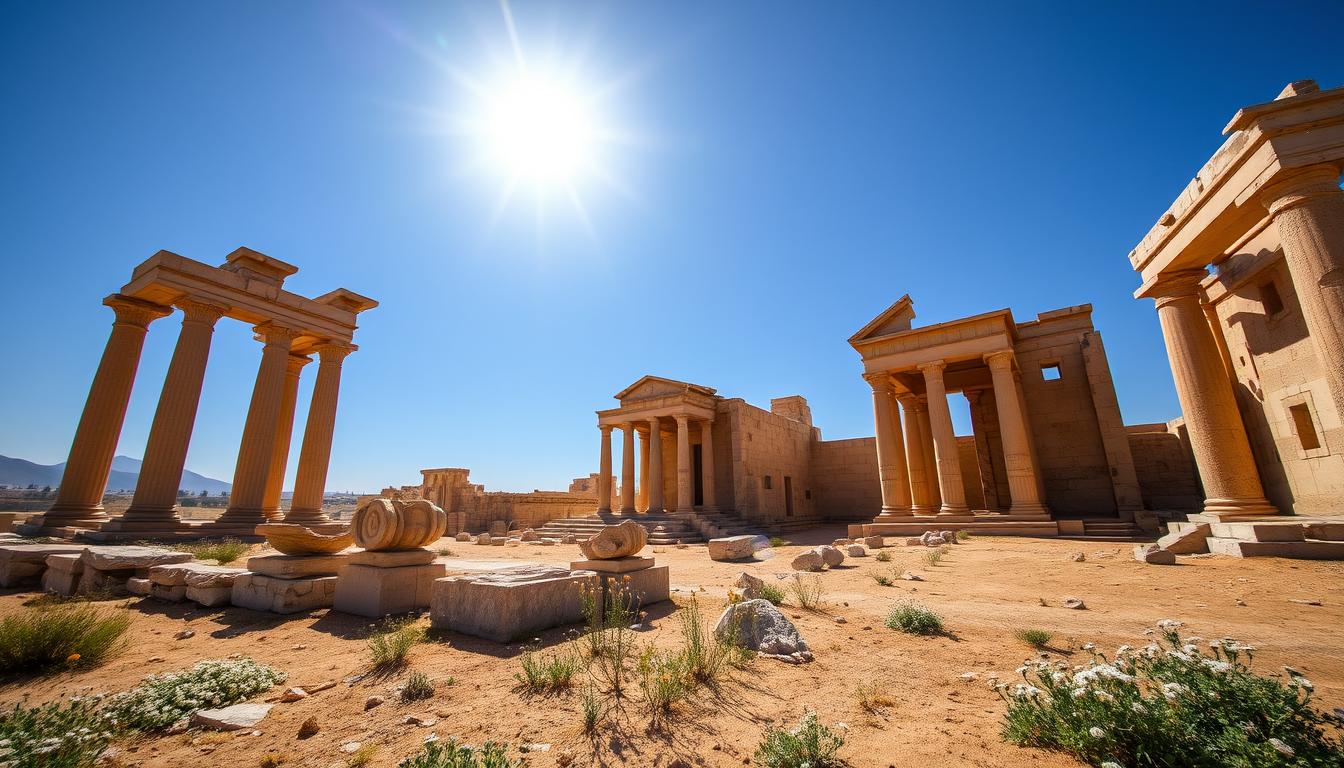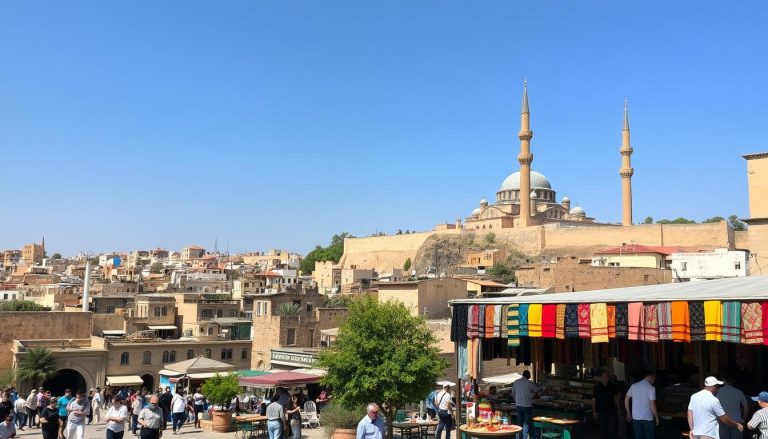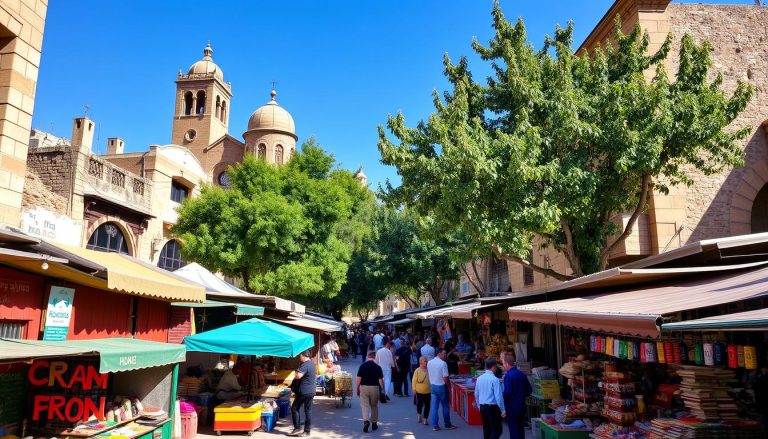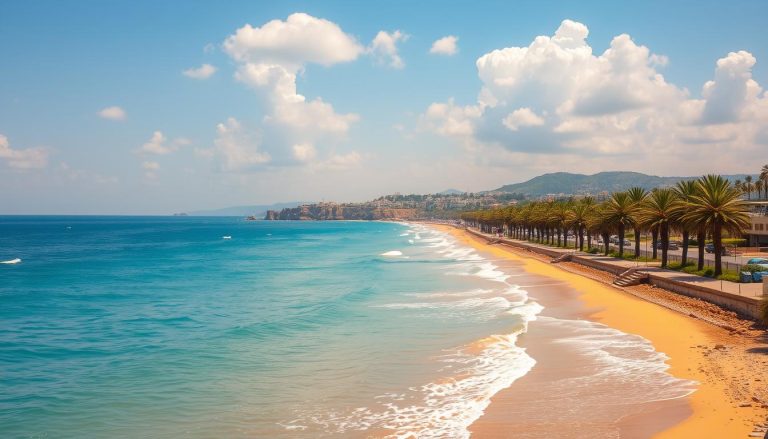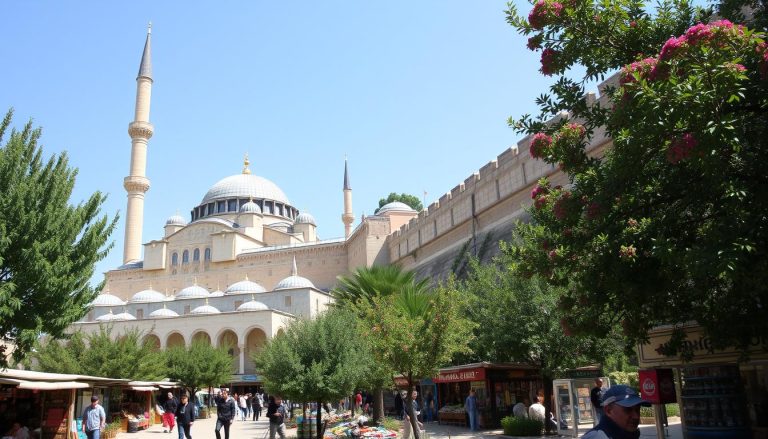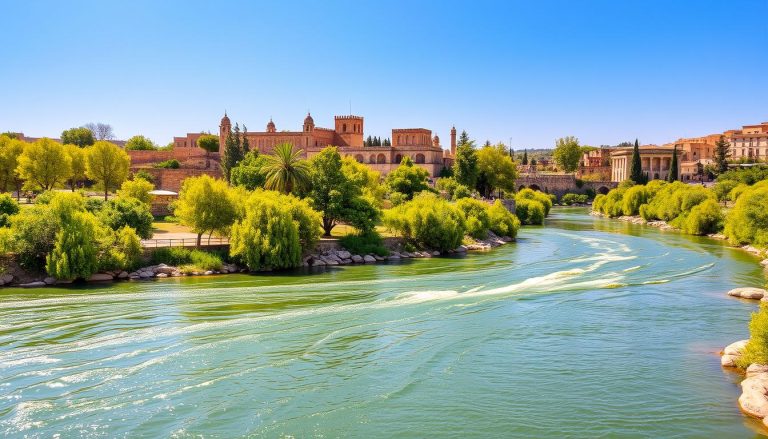Are you ready to travel back in time to ancient Palmyra? This UNESCO World Heritage Site is in the Syrian desert. It’s a mix of Greco-Roman architecture, Middle Eastern history, and stunning natural views.
Palmyra’s ruins, like the Temple of Bel and the Valley of the Tombs, take you centuries back. They show the rich culture of this desert oasis. Whether you love history or adventure, Palmyra offers an experience you won’t forget.
Key Takeaways
- Explore the ancient Greco-Roman ruins and UNESCO World Heritage Site of Palmyra in Syria
- Discover the historical significance and architectural marvels of the Temple of Bel and the Valley of the Tombs
- Immerse yourself in the captivating blend of Middle Eastern culture and history at this desert oasis
- Embark on an adventure that will challenge your assumptions and broaden your perspective
- Uncover the warm hospitality and cultural engagement of the local Syrian community
Introduction to Ancient Palmyra: A Desert Oasis
Palmyra was a bustling city in the Syrian desert oasis. It was key along the famous Silk Road. Today, it’s a UNESCO World Heritage Site, known for its Roman architecture and Greco-Roman style. Walking through its ruins is like stepping back in time, showing the city’s role in cultural exchange.
Historical Significance of the UNESCO Site
Palmyra was important because of its spot in the Syrian desert. It was a key stop on the Silk Road, linking Rome to India, Persia, and China. Its role in sea trade made it even more influential in the ancient world. Over time, it saw the rise and fall of empires like the Hittites, Sumerians, and Romans. Today, its architecture still amazes visitors.
Geographic Location and Climate
Palmyra is in the Syrian desert, with a desert oasis climate. The best times to visit are spring or fall, when it’s not too hot. Its location and climate helped make it a major desert hub.
| Feature | Description |
|---|---|
| Geographic Location | Situated in the Syrian desert, approximately 150 miles northeast of Damascus. |
| Climate | Hot, dry desert climate with average temperatures ranging from 95°F (35°C) in the summer to 60°F (15°C) in the winter. |
| Best Time to Visit | Spring (March-May) or Fall (September-November) when temperatures are milder, allowing for comfortable exploration of the archaeological site. |
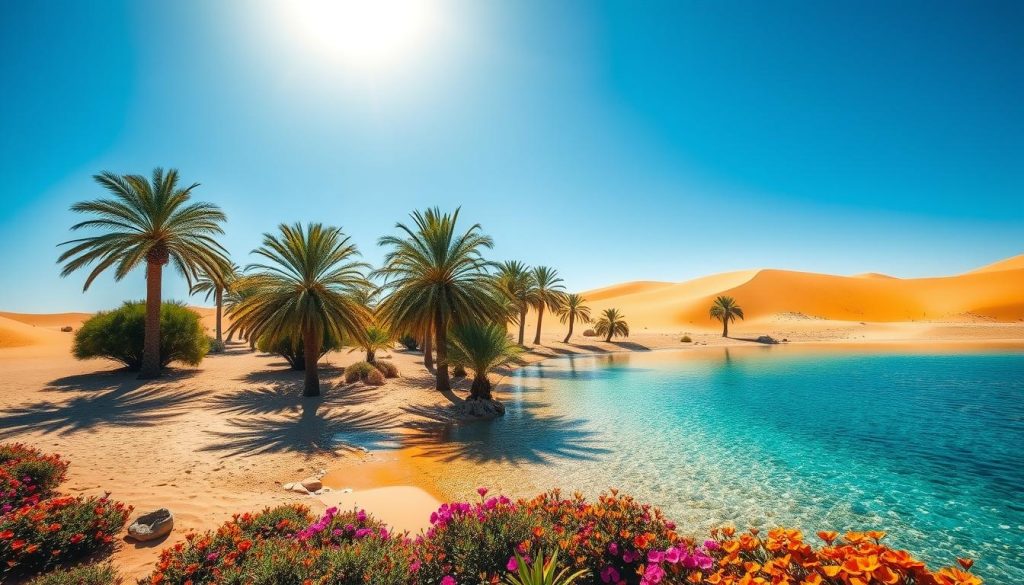
“Palmyra, a ghostly forest of arches and columns, where the remains of a once-great city stand in silent testimony to its former glory.”
Getting to Palmyra: Transportation and Access Guide
Getting to Palmyra, a UNESCO World Heritage site in Syria, needs careful planning. This is because of the country’s current situation. Visitors usually book their travel through licensed tour operators or local guides. This ensures a safe and smooth trip.
The most common way to get to Palmyra is from Damascus or Beirut. The trip from Beirut to Damascus, about 115 km, takes 2 to 4 hours. This includes time for customs. Shared taxis cost around $20 per person, while private trips can be about $100.
If you’re coming from far away, remember the visa process. It takes about 2 weeks to get a tourist visa for Syria. The cost varies by nationality, from $75 for Europeans to $200 for Americans. There’s also an exit fee of 2,000 Syrian Pounds.
| Passport Holder | Visa Fee |
|---|---|
| European | $75 |
| Canadian | $100 |
| British, Australian, Argentinian | $150 |
| U.S. | $200 |
In Palmyra, local transport is limited. So, it’s best to plan ahead with a trusted agency or guide. This makes exploring the ancient city’s wonders easy and enjoyable.
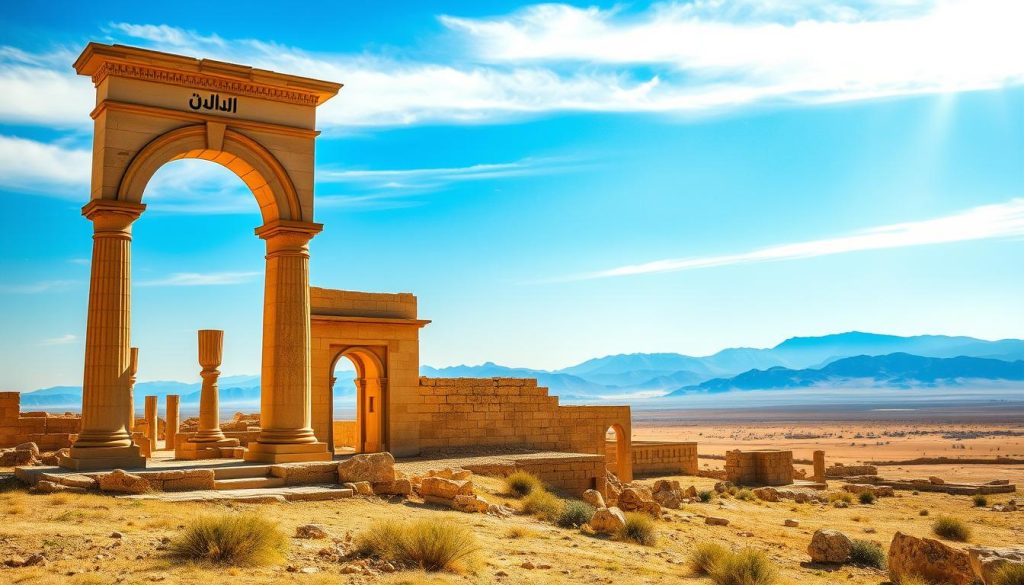
Visiting Palmyra is worth the effort. Its history, architecture, and landscapes are breathtaking. It’s a top spot for Syrian travel and Middle Eastern transportation fans.
Essential Things to Know Before Visiting Palmyra
Visiting Palmyra in Syria is a journey through ancient times. It’s important to plan well and prepare. Here are key things to know for a safe and successful trip to this UNESCO World Heritage site.
Safety Considerations
Some parts of Syria are getting safer for tourists, but others are still risky. Always check the latest travel advisories before you go. It’s wise to book with a trusted tour operator to stay safe.
Travel Documentation Requirements
Since 2018, you need a licensed tour operator to get a Syrian visa. The visa process can take up to two weeks. Make sure you have all your documents ready.
Local Customs and Etiquette
Respecting local customs is key when visiting Palmyra and Syria. Dress and behave appropriately and be aware of cultural norms. Tipping is common, around 2-7% of the tour cost.
Knowing these tips will make your visit to Palmyra better. It’s a unique chance to see Syrian culture and follow Middle Eastern travel tips.
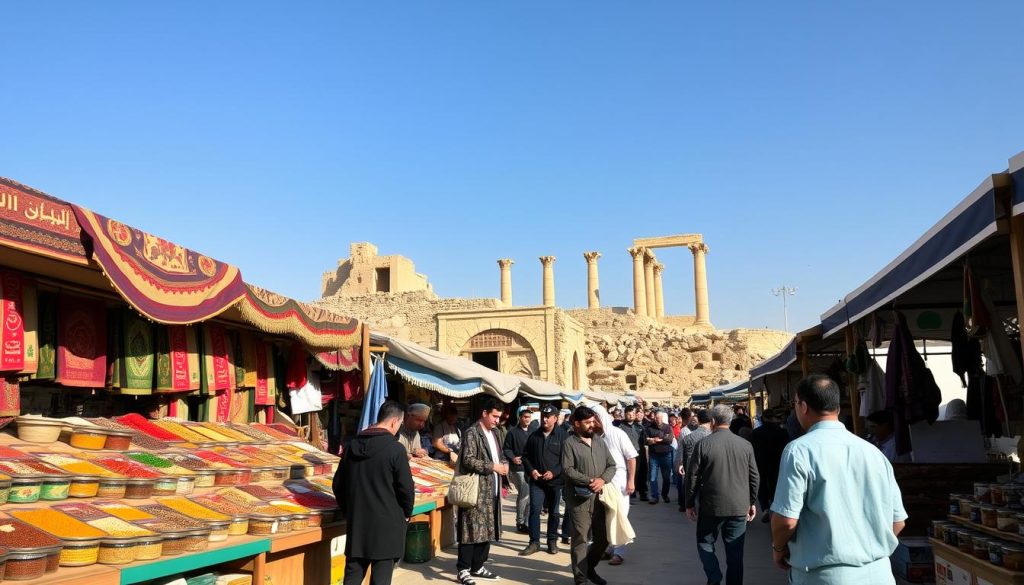
| Tip Category | Recommended Amount |
|---|---|
| Tour Guide | $100 USD per person |
| Driver | $100 USD per person |
| Discretionary Tip for Tour Guide | At traveler’s discretion |
Be ready for infrastructure challenges and limited services. Syria has been damaged by conflict. With a good tour operator and knowledge, you can enjoy the Syrian culture and Middle Eastern travel tips.
Exploring the Ancient Roman Theater
In the heart of Palmyra, Syria, lies the Greco-Roman amphitheater. It’s a symbol of the area’s rich history. Built in the 2nd century AD, this theater lets visitors see what life was like back then.
The Roman Theater in Palmyra is known for its amazing architecture. It has great acoustics and detailed designs. Walking through the seats, you can almost hear the sounds of old performances.
Visiting the Roman Theater gives you a peek into Roman engineering and entertainment. The theater’s design shows the Romans’ skill in building. It could hold many people and had sound quality without modern tech.
If you love Greco-Roman amphitheaters or want to learn about Syrian archaeology, this is a place you must see. It’s a chance to experience the past’s grandeur and imagine the performances that once took place here.
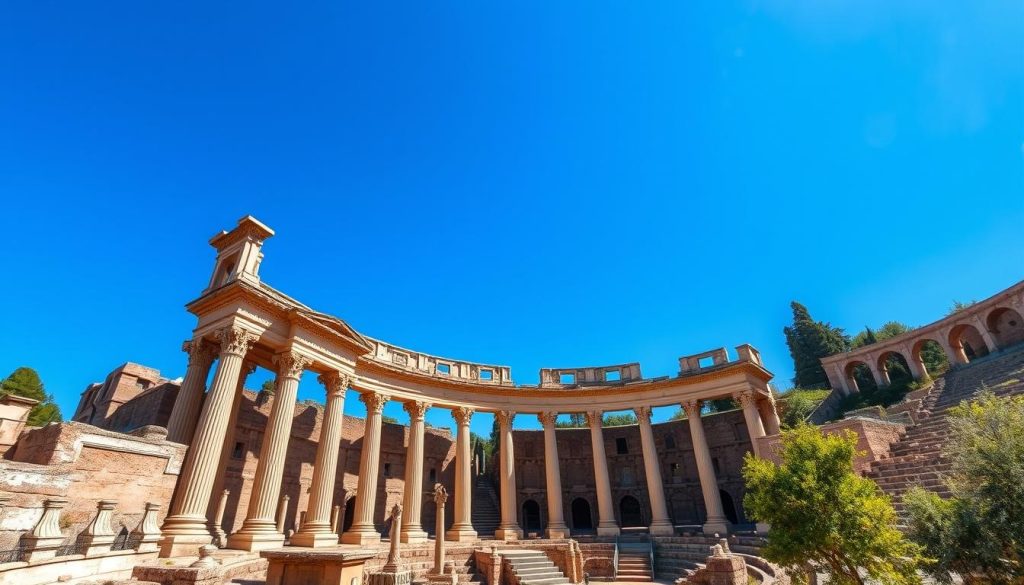
“The Roman Theater in Palmyra is a stunning example of the ingenuity and architectural brilliance of the ancient world. Its well-preserved state and breathtaking setting make it a must-see for anyone exploring the rich history of Syria.”
The Temple of Bel and Archaeological Wonders
In the ancient Syrian city of Palmyra, the Temple of Bel stands as a two-thousand-year-old marvel. It was once the most important religious site in the area. The temple’s design mixes Greco-Roman and Middle Eastern styles, showing the rich culture and history of Palmyra.
Architecture and Design Features
The Temple of Bel’s design shows the skill of its ancient creators. Its grand entrance, detailed carvings, and large size show its importance. The “Cella,” or innermost part, is especially striking, blending Semitic and Hellenistic styles.
Historical Significance
The Temple of Bel was more than just a building. It was a center for worship and culture in ancient Palmyra. It was a place where people came to honor their gods and share in community life. People from all over the ancient world visited this temple.
Current State and Preservation
Unfortunately, the Temple of Bel and other sites in Palmyra have been damaged by war. The “Cella” and parts of the Temple of Baalshamin were destroyed by the Islamic State. But, efforts are being made to save and restore these sites. This way, future generations can learn about and appreciate these ancient wonders.
| Architectural Feature | Description |
|---|---|
| Colonnaded Entrance | The temple’s grand, imposing entrance, featuring a row of impressive columns, reflects the Greco-Roman influence in its design. |
| Intricate Carvings | The temple’s walls and structures are adorned with intricate carvings and decorative elements, showcasing the artistic prowess of its builders. |
| Semitic and Hellenistic Influences | The combination of Semitic and Hellenistic design elements in the temple’s “Cella” highlights the cultural fusion that characterized ancient Palmyra. |
“The Temple of Bel in Palmyra is two thousand years old, a true testament to the architectural wonders of the ancient world.”
Exploring Palmyra’s ancient sites takes us back in time. We see the lasting impact of these Syrian temples and ancient architecture. Despite challenges, efforts to save these sites give us hope for their future.
Valley of the Tombs: A Journey Through Time
In the heart of the Palmyrene desert, the Valley of the Tombs awaits. It’s a window into the burial customs of the Palmyrene people. Here, you can see the Palmyrene funerary art and learn about Palmyra’s past.
The Valley is filled with tower tombs and underground hypogea. These are covered in sculptures and inscriptions. They show us how the Palmyrenes buried their dead, giving us a peek into their lives.
Walking through the Valley, you’ll see amazing carvings and reliefs. These artworks highlight the Palmyrene artisans’ skill. They also reveal the beliefs and ways of life of the ancient Palmyrenes.
| Tomb Type | Architectural Features | Artistic Highlights |
|---|---|---|
| Tower Tombs | – Multi-tiered structures- Elaborately decorated facades- Carved entryways and niches | – Funerary sculptures- Bas-relief carvings- Intricate inscriptions |
| Hypogea | – Underground burial chambers- Complex network of tunnels and halls- Vaulted ceilings and arched doorways | – Wall paintings- Carved sarcophagi- Funerary reliefs |
Visiting the Valley of the Tombs is an unforgettable journey. It lets you explore ancient Palmyra’s history and culture. As you explore, you’ll feel like you’ve traveled back in time, surrounded by the stories of the Palmyrenes.
“Palmyra, the ‘Pearl of the Desert,’ is a place of unparalleled beauty and historical significance. The Valley of the Tombs stands as a testament to the ingenuity and artistry of its ancient inhabitants, inviting us to uncover the secrets of their fascinating civilization.”
Palmyra, Syria: Best Things to Do - Top Picks
The ancient city of Palmyra is in the Syrian desert’s heart. It’s full of archaeological wonders and cultural experiences. Make sure to visit these top spots when you’re there.
Must-See Archaeological Sites
Don’t miss Colonnade Street, a grand Roman avenue with towering columns. It once linked the city center to the Temple of Bel. The Palmyra Museum nearby has amazing artifacts, sculptures, and mosaics. They show the area’s rich Syrian tourism and archaeological tourism history.
For a view that takes your breath away, go to the Citadel. It’s an ancient fort on a hill with a stunning view of the desert. Try to visit at sunset for the best golden light.
Cultural Experiences
Meet the local Bedouin community and learn about their crafts and life. Visit a Bedouin camp to see weaving, try local food, and understand the area’s culture.
Photography Opportunities
Palmyra is perfect for photographers. Its ancient buildings and desert views are amazing. Take pictures of the columns, the Citadel, and the glowing sand in the sunlight.
Palmyra is unforgettable for those interested in archaeological tourism or cultural experiences. Explore this desert gem and discover its history and beauty that have amazed visitors for centuries.
Local Experiences and Cultural Encounters
Visiting Palmyra, Syria, means diving into the Bedouin culture. You’ll meet the local community and see their traditions. Enjoy Syrian tea in a Bedouin tent, known for its warm hospitality.
Check out the local markets for handmade crafts and textiles. Bargain with vendors and see modern Syrian life. These moments offer a peek into the lives of Palmyra’s people.
Bedouin Hospitality and Traditions
Accept a desert tent invitation to feel Bedouin warmth. Sit on the floor, drink tea, and talk with your hosts. They’ll share their nomadic ways, weaving, and ancient rituals.
Exploring Local Markets
Walk through Palmyra’s markets for unique goods. Haggle with vendors who are proud of their work. These markets show the local community’s daily life and economy.
| Cultural Experiences | Highlights |
|---|---|
| Bedouin Hospitality | – Sharing tea in a desert tent – Learning about nomadic lifestyle and traditions |
| Local Artisan Markets | – Haggling with friendly vendors – Discovering handcrafted textiles, glassware, and more |
| Interacting with Locals | – Gaining insights into contemporary Syrian life – Witnessing the resilience of communities near ancient sites |
By exploring Palmyra’s markets and Bedouin culture, you’ll understand its people’s strength and traditions. These real experiences will make your visit unforgettable.
“The Bedouin way of life is a testament to the human spirit’s ability to thrive in even the harshest of environments. Engaging with this community is a humbling and enriching experience.”
Where to Stay and Dine in Modern Palmyra
In modern Palmyra, you’ll find a few small hotels and guesthouses. They serve as a good base for exploring the ancient ruins. Some people choose to stay in nearby cities like Homs or Hama. This way, they can enjoy local Syrian food and hospitality while visiting Palmyra.
Accommodation Options
For a real desert feel, stay at one of Palmyra’s small guesthouses or boutique hotels. These places offer a cozy place to rest after seeing the historic site. They often have traditional Syrian architecture, giving you a peek into local life.
Local Cuisine Recommendations
Eating in Palmyra is a treat for your taste buds. Try dishes like shawarma, falafel, and fresh local bread at family-run restaurants. Many places have great views of the ancient ruins, making meals even more special. Don’t miss out on trying local specialties and fresh produce for a full culinary adventure.
